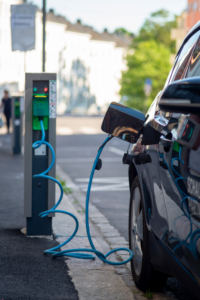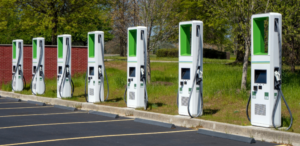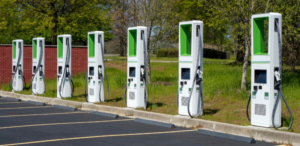On June 20, 2024, NCCETC staff held a Requirements for Federal Funding for Electric Vehicle (EV) Charging Infrastructure webinar to give a breakdown of the necessary components when it comes to applying for one of the many EV funding programs in the United States. To watch the recording, visit NCCETC’s YouTube Channel. This webinar is part of the Sustainable Fleet Technology Webinar Series in which industry professionals analyze challenges, demonstrate areas of potential operational improvement, and share innovative strategies and technologies that fleets are implementing across the country. Registration is free for all SFT webinars, so be sure to sign up for upcoming webinars being offered September 18, October 2, October 23, November 20, and December 4.
Clean energy policy experts Anne Blair (Electrification Coalition), Dr. Thomas Stout (HDR), and Eleni Petrow (TRC) each tackled an area of federal funding programs, beginning with an overview of Build America, Buy America (BABA). Anne Blair is the Vice President of Policy at the Electrification Coalition, a non-profit that works to reduce the United States’ oil dependence and reimagine the transportation sector to support economic development.

In Blair’s overview of BABA, she explains the act was passed by congress and signed by President Biden in November 2021 as part of the Infrastructure Investment and Jobs Act, also known as the Bipartisan Infrastructure Deal. The goal is to build a resilience supply chain and manufacturing base for critical products used for EV infrastructure in the United States. BABA mandates that all iron, steel, manufactured products, and construction materials used in projects supported by federal funds must be produced in the United States. Products that are considered produced in the U.S. must be 1) manufactured in the U.S., and 2) the costs of components mined, produced, or manufactured in the U.S. are greater than 55% of the total cost of all components of the manufactured product. Federal funding programs that are relevant to BABA include the Federal Highway Administration (FHWA) Reduction of Truck Emissions at Port Facilities, National Electric Vehicle Infrastructure (NEVI), Charging and Fueling Infrastructure (CFI), the Department of Transportation (DOT) Port Infrastructure Development (PIDP), and the Environmental Protection Agency (EPA) Clean Ports, Clean Heavy Duty Vehicles (CHDV), and Clean School Bus Program.
Dr. Thomas Stout works as an Inductive Pavement Lead at HDR, and shared NEVI guidance and requirements with the attendees. The Corridor aspect of the program has spacing requirements of less than 50 miles between stations. The stations also must be within one mile of an Alternative Fuel Corridor (AFC). All AFCs must be constructed first before stations and other infrastructure can be placed. Dr. Stout notes that an important aspect of spacing requirements within the program is that the distance is measured in driving miles.
Before diving into the rule requirements of the NEVI program, Dr. Stout defined key terms used throughout the guidance. A station refers to the area where EV chargers are located; a charger is the equipment that converts power from the grid (AC) to the battery (DC). Connectors are the physical connections to the car and there are multiple types including Combined Charging System (CCS), North American Charging Standard (NACS), and CHAdeMO. A port is a single output from the charger that can charge one vehicle at a time. Dr. Stout explained that this is a logical construct as ports are physically made up of chargers and connectors. He says, “if one vehicle can be charged, that is one port; if two can be charged at a time, then that same hardware counts as two ports.” The requirements for NEVI are written around ports rather than chargers, connectors, or stations.
The NEVI rule requires a minimum of four ports with a CCS Type 1 connector on each port. Power sharing among ports is allowed, but the power cannot be reduced below 150kW per port. There is also an output requirement of between 250 and 920 V DC. Charging stations must also support contactless credit and debit payment methods as well as an automated toll-free phone or SMS payment option. The charging stations need to be maintained and operational for at least 5 years, and there are standards specified for interoperability such as charger-to-EV, charger-to-network, or network-to-network.
There are also requirements for qualified technicians under the NEVI program. Those installing, maintaining, or operating chargers must have appropriate licenses, certifications, and training. Electricians are required to be either Electric Vehicle Infrastructure Training Program (EVITP) certified, or a graduate of a DOT and Department of Labor (DOL) approved electrical apprenticeship program. If there is a need for more than one electrician, at least one will need to be enrolled in a registered apprenticeship program.
There are ADA and multilingual requirements as well, that state multilingual users and those with limited English proficiency must be accommodated. Charging stations need to be accessible for individuals with disabilities and need to comply with ADA standards.
Dr. Stout ended the run-through of NEVI requirements with guidelines for data availability, and stated price has to be communicated in $/kWh, real-time data must be provided to third parties through a free Application Programming Interface (API), and all ports need to maintain 97% up-time.
Eleni Petrow, Senior Director at TRC’s Clean Transportation Solutions team, shared an in-depth review of Federal Reporting Requirements. The three main reporting requirements include progress reports, site visits/technical assistance, and audits which are required for grantees expending more than $750,000 in federal dollars in one fiscal year. Petrow also lists the standard federal reporting forms as follows:
- Performance progress reports/research performance progress reports (PPR/RPPR)
- SF-425 Federal Financial Report
- SF-270 Request for Advance or Reimbursement
- SF-271 Outlay report and request for reimbursement for construction programs
- SF-428 Tangible personal property
- SF-429 Real property status report
- SF-LLL Disclosure of lobbying activities – as revised in 1996
- SF-SAC Data collection form for single audits
DOT and FHWA require data reporting that is quarterly for charging stations and ports, annual for maintenance and repair cost per station, and on-time for entities involved in operations and maintenance.
There is also a public accessibility component for certain projects. AFC projects must be publicly accessible at all times and community projects need to be accessible during regular business hours. Petrow says the accessibility of shared fleet projects is currently under discussion which could be an opportunity for individuals to engage with their local DOT to advocate for shared fleet projects.
 Petrow also discussed the Federal Transportation Improvement Program (FTIP), which is managed by the Metropolitan Planning Organizations (MPOs) and the Regional Transportation Planning Agencies (RTPAs). All FHWA projects must be included in an approved FTIP. She stated to “look at these agencies as your partners, work closely with them, and ask for guidance”.
Petrow also discussed the Federal Transportation Improvement Program (FTIP), which is managed by the Metropolitan Planning Organizations (MPOs) and the Regional Transportation Planning Agencies (RTPAs). All FHWA projects must be included in an approved FTIP. She stated to “look at these agencies as your partners, work closely with them, and ask for guidance”.
A great resource to find more detailed information about incentives and state requirements is the Alternative Fuels Data Center.
Make sure to sign up for the remaining SFT Webinars this year to learn more about the latest and greatest clean transportation programs and technologies!


 The Notice of Funding Opportunity (NOFO) has been announced and offers up to $932 million in funding under the Clean Heavy-Duty Vehicles Program. The deadline to apply is July 25, 2024, and the EPA plans to notify those selected by November 2024, and award grants by February of the following year. Those who are eligible to apply include States, United States territories, municipalities, public school districts, Indian Tribes, and non-profit school transportation associations. The vehicles eligible under the program are Class 6 and Class 7 school buses, along with other Class 6 and 7 vehicles like dump trucks, transit buses, delivery trucks, utility trucks, and other box trucks.
The Notice of Funding Opportunity (NOFO) has been announced and offers up to $932 million in funding under the Clean Heavy-Duty Vehicles Program. The deadline to apply is July 25, 2024, and the EPA plans to notify those selected by November 2024, and award grants by February of the following year. Those who are eligible to apply include States, United States territories, municipalities, public school districts, Indian Tribes, and non-profit school transportation associations. The vehicles eligible under the program are Class 6 and Class 7 school buses, along with other Class 6 and 7 vehicles like dump trucks, transit buses, delivery trucks, utility trucks, and other box trucks.